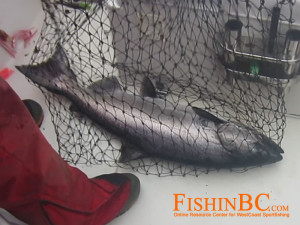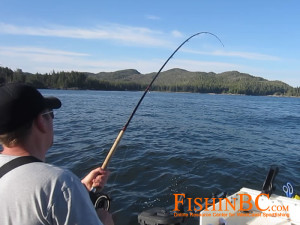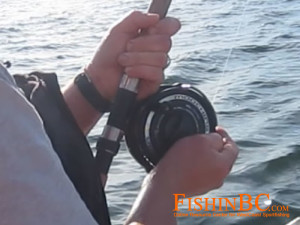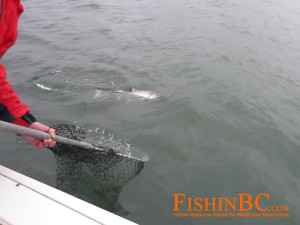
- rod selection
- fighting techniques
- boat handling
Ten salmon fishing tips within these three major areas are guaranteed to get you a high percentage of successful salmon landings. Focus and attention to detail makes the difference between boats with lots of salmon and boats with few. At FishinBC.COM we want you to land more salmon than the average angler.
#1 – Long Salmon Fishing Rod for Mechanical Advantage
A long salmon fishing rod gives the advantage to the angler. Short rods can convenient on small boats but they give up the mechanical advantage gained with a long fishing rod. A 9′ rod should be the absolute minimum and my preference is the 10’6 mooching rods that are made by various manufacturers in the $100-200 range. Longer salmon fishing rods can be ordered or custom made but the cost can be prohibitive for many. Really long rods are also difficult to store and for this reason may not be used as much.

#2 – Medium Weight Rod with Lots of Flex
The weight rating of the rod is also an important characteristic of a salmon fishing rod that relates to the same concept as detailed for the length. A super heavy weight tuna rod will not flex much with a salmon on it so it will not bend much and will not take up much slack. A medium weight rod is ideal for salmon fishing because it will generate the right amount of curve with an average sized salmon on the rod. Too light a rod and it might break when your trophy fish finally comes along.
#3 – Ensure the Hook is Sticky Sharp
Salmon fishing requires a sticky sharp hook to give maximum advantage to the angler. Anglers should check their hooks every time they rig a new bait. Barbless hooks out of the box are typically laser sharp but it does not take long for these hooks to start to break down. Anglers would be surprised at how dull their hooks can become after catching a few fish or potentially pounding against rocks or driftwood or even seaweed in the ocean. If a hook is really beaten up badly with a broken tip or other damage then the easiest option is to replace it with a brand new laser sharp hook. If the hook only needs a light touch-up then the angler can use a hook file and lightly touch up the hook. For additional details on hook sharpening refer to this FishinBC.COM article:
Related Article: Hook Sharpening Tips for Maximum Impact
#4 – Set the Hook
Chinook salmon have relatively tough mouths and a proper hook set is important to ensure the barbless hook has fully seated into the mouth of the salmon. If the angler is using a downrigger then by setting the line deeply in the downrigger clip, the fish will automatically start to set the hook when it rips the line out of the release clip. Once the fish is hooked the angler can grab the rod and give another sharp pull or two upwards to ensure that the hook is fully set in the mouth of the salmon. Once one or two hooksets have been completed additional pulls are not required. Over setting the hook will tend to enlarge the small hole in the mouth of the salmon and this can make it easier for a barbless hook to work its way free.
#5 – Keep the Tip Up
Everyone has heard about keeping the rod tip up and this is definitely one of the most important factors when salmon fishing. A lot of people do not truly realize why and the reason is entirely within the paragraph about the length of the rod. A rod that is held high and pointing upwards has a big curve and the big curve is what gives the advantage to the angler. If the rod is held low then the curve will not be as big as it could be and the angler is wasting some of the advantage.
#6 – Set the Drag Tension Correctly

#7 – Keep the deck Clean and Clear
A clean and clear deck is critical for effective salmon fishing. Moving around the deck is important for the angler fighting a salmon because the fish tend to change directions on a dime and the angler may have to move from one side of the boat to the other multiple times during a fight. To give maximum advantage to the angler the boat deck should be clean, organized, and clear of tackle boxes, water bottles, and any other gear that can be stowed in any other location. If the fish swims around the stern and the motor the angler will need to move quickly to ensure the line clears the motor and get around the other people in the boat and over to the other side.
#8 – Wait for Multiple Hookups
If salmon fishing with multiple rods and a fish strikes, the angler should grab the rod and decide where the fish is heading and then depending on its path, it can be reasonable to keep the other rods fishing. Chinook salmon typically head straight down and away and are not likely to get into the other rods right away if the boat continues in a forward direction. A good tip for salmon fishing anglers is to keep the boat moving for a little bit longer for the potential to get a double-header. If after a short while there is no double-header then the captain should advise if pulling up the other gear is warranted. If its a large salmon then pulling up all the gear is necessary. If its only a small fish or a coho or pink, then it may be possible to bring the fish in on one side and keep the boat moving forward all the while and the gear on the other side still in the water.
#9 – Actively Maneuver the Boat
A maneuver is defined as a series of tactical moves. In the case of salmon fishing with barbless hooks, the captain can maneuver the boat to leverage a tactical advantage to the angler. When salmon fishing, not all captains follow the fish but its true value is easily evidenced by looking at marlin fishing and other extreme sized fish. The boat captains constantly operate the boat to keep the fish behind the boat and give their anglers the maximum advantage. The same holds true for salmon fishing with barbless hooks especially when dealing with large and aggressive chinook salmon.
I like to maneuver the boat to try and keep the fish on one side of the boat, generally the drivers side and slightly to the back. Having the fish on one side is useful because the angler does not have to worry about trying to get the fish around the bow, or around the motor. The angler also does not have to worry about footwork, moving around other anglers, the net, or falling if they are elderly or it if it is rough. By keeping the fish on the captains side, this makes it easy for the captain to look out the side and see the fish.
Boat speed is an important factor when salmon fishing with barbless hooks. If the fish is screaming out line behind the boat, forward movement is not required and the captain can adjust to this situation by shifting temporarily into neutral. The fish is likely to turn around abruptly and start screaming back toward the boat at any moment so the captain needs to be ready to shift the boat back into gear slightly and start moving again. This preparedness is important because some fish can swim toward the boat faster than anglers can reel, especially if a lot of line is out and the diameter of the spool is not taking up as much line per crank. By applying some drive and heading away from the fish the angler can catch up on reeling and ensure that the rod tip is always up and with maximum curve. The re-application of throttle from neutral can be tricky if the captain is fighting the fish and a guest is at the helm. It is worth training your anglers at helm operation and especially shifting and throttle response so that they are familiar with the boat and the amount of throttle required to get a response. Keeping the boat moving is useful because it gives the fish more time to tire out before it gets right up to the boat.
A salmon that is allowed to swim around the bow causes extreme difficulty to the angler. To correct for a fish heading around the bow, the captain should be prepared for the situation and slightly reverse with a slight turn to swing the bow away from the fish. Once the bow has swung some forward gear will put a little distance between the boat and the fish and this is favorable for playing the salmon.
A fish that is directly straight down beneath the boat is not a big problem if it is a long ways down, but if the fish is right near the surface and right near the boat it is a risky situation especially if salmon fishing with barbless hooks. The fish may start thrashing and the slightest slack line could cause the fish to get off. As the captain in this situation it is worthy to engage drive and move the boat either forward or using the backward swing turn to put a bit of distance and angle between the fish and the boat.
When the fish is ready to be netted, the captain needs to observe the fish and decide if neutral, or forward gear is appropriate. Sometimes, a good approach is to operate in gear slowly if the fish is tired and swimming about the speed of the boat, from behind the boat. The angler can reel the fish in and then when the salmon is almost at the boat, a shift into neutral will cause the fish to gain the last 2-3 feet quickly and right into the awaiting net. At other times, an extremely tired fish may float almost belly-up at the side of the boat and this case the captain should engage neutral and allow the angler to raise the fish and direct its head toward the net so it will swim in.
#10 – Net the Fish with Patience

Once the fish is exhausted it will either swim behind the boat slowly and consistently if the boat is in gear, or, it will be alongside the boat and swim on its side, indicating it is tired out. At this time the angler should move from the side of the boat where the fish is on, to the opposite side of the boat, giving up the rail to the netter. Use your knowledge of rod length and holding the tip high (from this article) to give you confidence to play the fish effectively and fully tire it out. The netter should hold the loose bag of the net in one hand and the handle in the other. The angler should lift the rod and direct the head of the fish toward the net, and then the netter can quickly lower the net into the water in front of the fish and the fish will swim right into the net. Fish cannot swim backwards so a properly placed net in front of the fish is an excellent technique. When raising the net the netter should pay attention to lift the net vertically by the frame and not by the handle. Lifting a heavy fish by the handle can result in a broken net.
Salmon Fishing Conclusions
Salmon fishing can be a stressful experience for the inexperienced but through the implementation of strategic measures the captain crew and angler can shift the advantage from the fish back to the angler. The angler must be prepared for a lengthy battle and must avoid temptation to horse the fish into the boat. Patience, combined with the right rod length and an experienced boat operator and netter will generally result in the successful capture of that trophy fish and a great salmon fishing experience.
If the fish does get off it is important to take a look at the scene and figure out what went wrong and what can be changed for the future to ensure that overall the crew has a high success rate. Angling is, in this regard similar to poker, where even aces get cracked from time to time but overall, with a systematic method the experienced poker player can have an winning record. Attention to the small details is very important because at the end of the day, everyone on the ocean generally has a good time but the crew that comes back having landed a record catch has an even better time and the great memories will last forever.
We hope you’ve enjoyed this article and if you found it useful please share it with your fishing team and friends, and check back to FishinBC.COM from time to time for new and related posts.
Tight Lines…FishinBC.COM!
My husband wants to go salmon fishing when we go on our anniversary trip to California. I found it interesting that you mentioned that it’s important to keep the tip up to give you the advantage. After reading your tips, I am excited to try salmon fishing and I hope we can find a beautiful place to do it.
I wanted to thank you for this advice for salmon fishing. It’s good to know that you should try to keep a deck clean because fish could change directions very quickly. It also seems important to make sure the deck isn’t too slippery so you don’t fall when you are changing positions.
Very nice write-up. I definitely love this site. Stick with it!